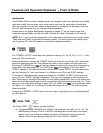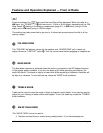
CCRadio SW Page 13
Features and Operation Explained — Front of Radio
S on the left side of the radio. Install “AA” or “D” size rechargeable batteries such as
Nickel Metal Hydride into the “AA” or “D” slots according to the diagram etched in the
battery compartment. Be very careful to orientate the batteries correctly as labeled.
Connect the radio to power using the supplied AC Adapter. While the radio is “off” and
the radio is connected to a power source, press the “CHARGE” button. The bat-
tery icon will flash during the charge cycle .
CHARGING TIPS: 1) The charging circuit will not work while the radio is turned “on”.
The charging cycle will resume when the radio is turned “off” and connected to power
with the AC Adapter. 2) The charge cycle shuts “off” after 12 hours whether the batter-
ies are fully charged or not. 12 hours is long enough to fully charge “AA” batteries. High
capacity “D” size batteries (9000 MAh) require three or four charge cycles to become
fully charged. The charge system is designed to stop charging if an attempt is made to
charge an already fully charged battery.
If you attempt to charge dead alkaline bat-
teries, they will leak, they will ruin your radio, and it will void your warranty.
2) When the radio is “on”, pressing and releasing the “CHARGE” button selects
stations stored to the memory presets. See “
MEMORY SET” (page 11) to store stations
to memory presets.
This button is best used to quickly step to the beginning of each of the commonly designated
SW broadcast bands. Example: In the evening turn the “AM/SW BAND” knob r to “SW1”.
Press the “SW BAND” button until it reads 9400 on the LCD display. Press and hold the
button to start scanning through this
SW band. Different SW Bands work better at different
times of the day, year and even solar cycle. (See “Common Shortwave Broadcast Bands”
below.) This button can also be used to increment through the
AM band by 100 kHz steps and
the
FM band by 1000 kHz steps.
SW BAND
{
<
2300 – 2495 120 Meters
3200 – 3400 90 Meters
3900 – 4000 75 Meters
4750 – 5060 60 Meters
5900 – 6200 49 Meters
7100 – 7450 41 Meters
9400 – 9900 31 Meters
COMMON SHORTWAVE BROADCAST BANDS
11600 – 12100 25 Meters
13570 – 13870 22 Meters
15100 – 15800 19 Meters
17480 – 17900 16 Meters
18900 – 19020 15 Meters
21450 – 21850 13 Meters
25670 – 26100 11 Meters


















